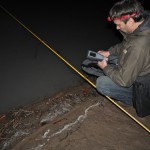
In the latest issue of The Advocate, we feature our intrepid Red, White & Water team, which was on the road in North Carolina over the last couple months meeting with people living near toxic coal ash ponds. The response was tremendous.
Led by our North Carolina campaign coordinator, Sandra Diaz, our team of interns and volunteers made hundreds of phone calls and knocked on dozens of doors. We teamed up with Dr. Avner Vengosh and his graduate students from Duke University to sample drinking water wells and test for the toxic chemicals associated with coal ash pollution.
People welcomed us into their homes, told us their worries about contaminated drinking water, and brought friends and neighbors to our community meetings where we shared information about coal plant pollution. And many of them are now getting involved to tell the government to enforce the laws that are meant to protect water resources and public health.
This is Appalachian Voices at our best — helping citizens get the information and tools they need to voice their concerns to elected leaders and other decision makers, making them powerful advocates for their families, their communities, and the environment.
Toward that end, we’re proud to be a co-sponsor of the first Southeast Coal Ash Summit this fall, where citizens can learn from state and federal officials, scientists, activists – and each other – about this significant threat to the South’s waters.
View images of the meetings and find out how you can get involved in our Red, White and Water campaign.
For our mountains and water,

 Since Sunday night, coal ash has been spilling into the Dan River from a coal ash pond at Duke Energy’s retired Dan River Plant in Eden, N.C. The spill began when a storm water pipe under the coal ash pond burst, causing coal ash to flow through the pipe into the river. Appalachian Voices water quality specialists traveled to the site of the spill to take photos, sample water and document the damage already done by the spill.
[ Read More ]
Since Sunday night, coal ash has been spilling into the Dan River from a coal ash pond at Duke Energy’s retired Dan River Plant in Eden, N.C. The spill began when a storm water pipe under the coal ash pond burst, causing coal ash to flow through the pipe into the river. Appalachian Voices water quality specialists traveled to the site of the spill to take photos, sample water and document the damage already done by the spill.
[ Read More ]















